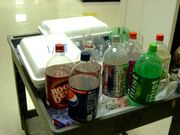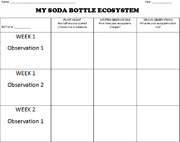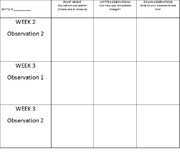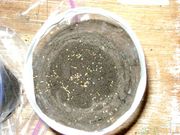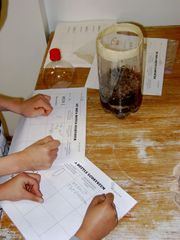Life in a Bottle
| Instant wiki maker | Making handouts | Editing tips |
Biology In Elementary Schools is a Saint Michael's College student project from a course that ran between 2007 and 2010 and fully described in this book chapter. The student-created resources have been preserved here for posterity. Link under 'toolbox' for printer-friendly versions of the exercises. Click on handouts to print full resolution versions. Please see Wikieducator's disclaimer, our safety statement, and the Creative Commons licensing in English and in legalese.
Student worthiness
Tried twice and worked well!
Primary biological content area covered
Students will learn about environmental science, and what it takes for different organisms to survive. They will learn about ecosystems, and how each organism in an ecosystem is dependent on each other. They will also learn about plant growth and record it each week.
For Student Use
- a 2-liter soda bottle for each student group
- scissors
- 6 bean seeds per bottle
- 2 pinches of grass seeds per bottle
- 2 pinches of clover seeds per bottle
- worms
- potting or garden soil (enough for 7.5 centimeters to be placed in bottle)
- gravel (enough for 1.5 centimeters to be placed in bottle)
- sand (enough for 6.5 millimeters to be placed in bottle)
- water
Handouts
This worksheet can be adjusted and modified to fit other grades and age levels.
Description of activity
This activity begins with the construction of an ecosystem. Students will love being able to watch what they made grow. These ecosystems consist of layers; the first layer is gravel, followed by dirt, sand, and then more dirt. In the final layer of dirt there is a series of plants, such as grass, clovers, and beans, which will grow over time. Along with the layers of soil and plants there are also a couple of worms living in the bottle. These worms will help to mix the layers together and, along with the water and plants, will help to keep the ecosystem alive over a long period of time.
BEFORE BEGINNING THE LESSON
- Gather materials needed
- Cut all 2 liter bottles where the neck starts to form. (see figure #) Place a piece of masking tape along the edge of the bottom half.
- Number all 2 liter bottles. Measure out in plastic baggies the necessary amounts for each of the steps below (this will save lots of stress and time during the lesson)
- Moisten the bags of dirt (water will soak into damp dirt better then dry dirt)
- Prepare an example bottle following the directions below (works best about a week in advance because there will be plant growth)
DURING THE LESSON
- Ask students how plants grow. - How do they get their nutrients? What do they need to grow?
- Ask students how animals may depend on their environment. - Where do certain animals get food? Where do they live?
- Explain the purpose of the lesson and what the students will be doing. -Students will be constructing their own ecosystems using empty 2 liter bottles of soda to see how worms and plants cohabit
- Split students into groups depending on size and amount of materials. For example, in a class of 20 students with 4 water bottles, students will work in pairs to create their ecosystems.
- Pass out a bottle and set of materials (soil, gravel, seeds, etc.)
- Place about 1/2" of gravel in the bottom of the bottle to aid drainage. Now loosely add 3" of potting soil. Tap the bottle so the soil will settle some, but not enough to pack it tight.
- Using a pencil, poke holes about 1" deep in the soil. Place a bean seed in each hole (plant them near the bottles edge in order to see the roots sprout and grow). Lightly recover the beans.
- Gently sprinkle the grass seeds over the top of the soil. Scratch the surface lightly with a fork to place the grass seed just slightly under the soil, but not too deep.
- Sprinkle water into the bottle until the soil is very damp but not soaked. Let it sit for a while and watch the water permeate through the soil. Sprinkle more water again until the soil is damp all the way down to the bottom.
- Place the top back on the bottle so it makes a snug fit.
- Have students fill out the Week 1 row of their charts.
- Wrap the bottom of the 2 liter bottle with tin foil and place in a warm sunny spot that at least receives indirect light for most of the day. Make sure it doesn't get too hot and bake the starting plants. Keep a daily log of your ecosystem's progress.
- Have students wash their hands and clean up their areas.
- Explain to students that this experiment will be revisited once a week and that continual observations will be made.
AFTER THE INITIAL LESSON
- Revisit the worksheet and ecosystems once a week over the next four weeks.
- Have students fill out the appropriate parts of the chart each week.
- Initiate dialogue within the entire class about what is happening in each individual ecosystem and how it is different from other ecosystems in the classroom.
Potential pitfalls
While running this experiment ourselves before the kids ran it, we learned areas that we should be very careful and very precise with. One is the amount of water that is poured into the bottle. If too much water is poured into the top, the worms and seeds can drown. One way to avoid this is to predetermine the amount of soil needed for each soda bottle, pour it into a Ziploc bag, and pour water into the bag until the soil is moist. You also want to make sure that the top of the bottle is on securely so that it does not fall into the ecosystem and also so that no water escapes from it. The finished bottles should not be placed in direct sunlight to ensure that the worms do not die. The tinfoil is a great way to ensure this.
Math connections
A math connection to this unit is made through the completion of the worksheet. Students are asked to complete a worksheet in which they observe their own ecosystem and are asked to measure their plants and record their findings over a couple weeks worth of time. This allows students to practice their measurement methods and work to find a wide range of growth/measurements.
Literature connections
A good book to read to students while discussing ecosystems is EcoMazes: 12 Earth Adventures, written by Roxie Munro. This children's book describes 12 different ecosystems from all areas of the world, giving information that the students might not know about areas in the world they might not have heard of before.
Connections to educational standards
VERMONT STANDARDS:
- S1-2:30 - Students demonstrate their understanding of Structure and Function-Survival Requirements by…
• Observing and recording the parts that make up living things (i.e., roots, stems, leaves, flowers, legs, antennae, tail, shell).
Science Concept:
a. Living things (plants and animals) are made of parts that enable survival.
- S1-2:34 - Students demonstrate their understanding of Energy Flow in an Ecosystem by…
• Experimenting with plant growth under different conditions, including light and no light.
Science Concept:
a. Plants need light (energy) to survive.
Information found here: [1]
Next steps
After you run this experiment you could do a number of different activities. This specific activity allows the students to continue observations on their ecosystem, and therefore allows for discussions on plant life, plant growth, and evaporation/the water cycle. These subjects yield many different activity ideas. You could also move this activity a step further and do activities, such as growing a garden, with your class. With this activity you could show the students the importance of watering the flowers, and also the importance of sunlight/food for the plants.
Reflections
KM- I personally feel that this was a very successful activity to run with the second grade students (and would be a good activity for all ages). It was great how the students were able to connect to the activity as they all enjoyed how the hands-on aspect (how they were able to touch the products and put it in the bottles themselves), their abilities to work together with their other classmates, and their final product. I did find, however, that the idea of an ecosystem was a foreign idea to the students, however, the water cycle was not and was therefore a good starting point to discuss with the students. Also, the only pitfall that I found was that we had used a little too much water at times in moistening the soil. We combated this by either adding more water to the wet soil in the baggies or by not adding as much water into the finish product (as the water in the soil would be enough to sustain the ecosystem). Personally, this was the first bottle ecosystem that I have created, and I consider this a very positive experience for me as well as the students involved.
HM- The students loved this activity. They were so excited to create this project, and couldn't wait for their seeds to grow into plants. It was very successful, with no spills or mishaps, and the students were able to make them quickly and efficiently. They also seemed excited to measure their plants once they grew. They were so excited about this activity that they named their worms, and one group even named the worms after us. The students learned a lot from this activity: not only biology, but working together to create something.
JM- This idea sprouted from an early science lesson I did when I was in 4th grade. Making my soda bottle ecosystem was one of my greatest childhood memories in a science class and I always wanted to replicate a personalized version of the lesson for my students one day. I was able to do this, along with my partners, for 2nd grade students of Mater Christi school. The lesson went great and the kids really enjoyed it. Of course there were little concerns, for instance if too much water was added or if the holes for the seed were too deep. Another concern was the students' attitudes towards worms and their willingness to pick them up. Each time we did it another thing came up, but we were easily able to solve any problem. I highly recompensed and encourage everyone to do this lesson in their classroom.
Citations and links
This idea was based off an idea that a Mr. R had for his boy scout troop. The link to his website is: http://www.relia.net/~thedane/ecosystem.html
Link for the Vermont Educational Standards
1. http://education.vermont.gov/new/pdfdoc/pgm_curriculum/science/grade_expectations/ge_grades_1-2_life.pdf

